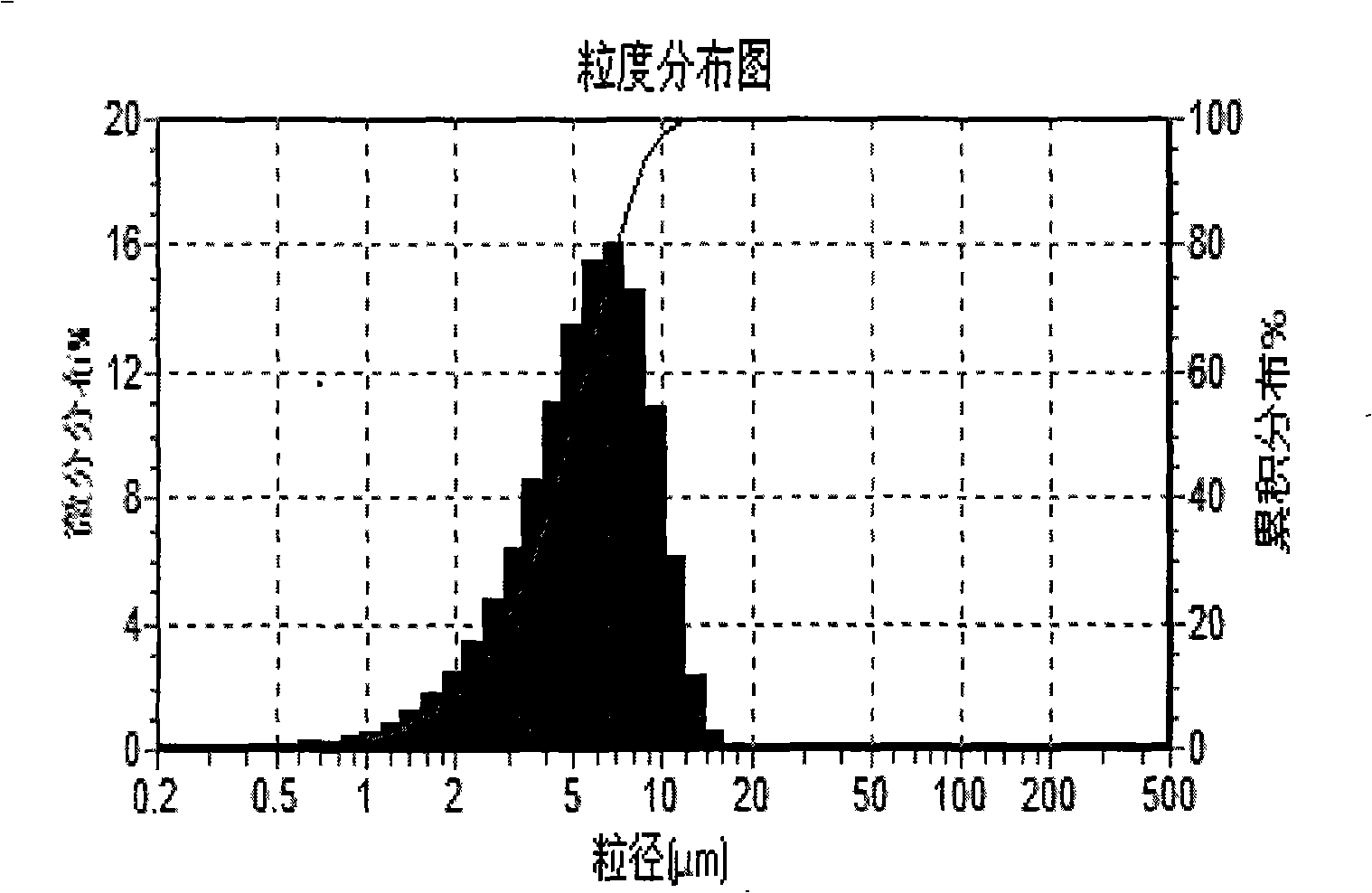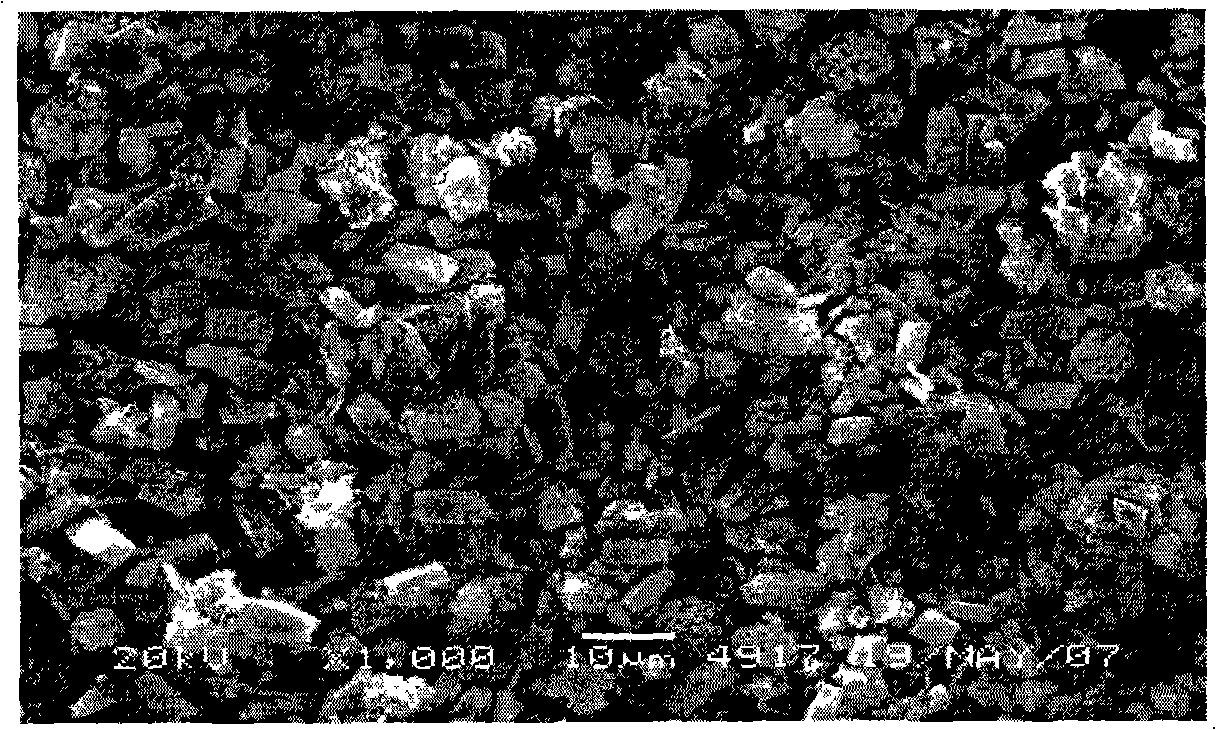Ultra-fine rare earth iron series magnetic alloy powder coprecipitation reduction scattering preparation
A magnetic alloy and co-precipitation technology, which is applied in the field of permanent magnet material preparation, can solve the problems that the particle size cannot reach the range of single-domain particle size, the magnetic performance of magnetic materials decreases, and the particle size of raw materials is large, so as to achieve complete grain structure and excellent magnetic properties. energy and reduce production costs
- Summary
- Abstract
- Description
- Claims
- Application Information
AI Technical Summary
Problems solved by technology
Method used
Image
Examples
Embodiment 1
[0019] Take 1.7mol / L FeCl 2 solution and 0.2mol / L SmCl 3 Each solution was 100ml, mixed at room temperature, heated to 28°C to adjust pH=1.5; then take 1.0mol / L (NH 4 ) 2 C 2 o 4 200ml of solution, heated to 28°C to adjust pH=4.2; fast feed in parallel flow, feed speed control is based on pH=2.5. After the feeding was completed, the temperature was raised to 40° C., and aged for 1.0 h. The aging process is NH 3 ·H 2 O and HCl were used to adjust the pH value to 2.5, and the stirring speed was controlled to be 200 rpm during the feeding and aging process. After the aging is completed, filter and wash the precipitate with hot water until the anion cannot be detected; after drying, the samarium iron oxalate precursor powder Sm 2 (C 2 o 4 ) 3 10H 2 O and FeC 2 o 4 2H 2 O, with a weight of 38.2g. After testing, the molar ratio of iron and samarium is 8.5:1; X-ray diffraction results show that it is a good crystal form, the powder particle size is between 1 and 20 μm,...
Embodiment 2
[0022] Take 0.17mol / L FeCl 2 solution and 0.02mol / L SmCl 3 Each solution was 100ml, mixed at room temperature, heated to 32°C, and adjusted to pH=2.0; then take 0.1mol / L H 2 C 2 o 4 200ml of the solution was heated to 32°C, and the pH was adjusted to 2.4; the feed was fed rapidly in parallel, and the feeding speed was controlled so that the pH of the reaction mixture was 2.0. After the feeding is completed, raise the temperature to 50°C, and age for 1.0h. During the aging process, use NH 3 ·H 2 O and HCl were used to adjust the pH to 2.0, and the stirring speed was controlled at 200 rpm during the feeding and aging process. After aging, filter and wash the powder with hot water until the anions cannot be detected. After drying, 3.85g of samarium iron oxalate precursor powder Sm 2 (C 2 o 4 ) 3 10H 2 O and FeC 2 o 4 2H 2 O.
[0023] The obtained samarium iron oxalate precursor powder was in N 2 Atmosphere, temperature 760°C, time 4 hours for calcination treatment...
Embodiment 3
[0025] Take 1.7mol / L FeCl 2 solution and 0.2mol / L LaCl 3 Each solution was 100ml, mixed at room temperature, heated to 30°C, and adjusted to pH=2.0; then take 1.0mol / L (NH 4 ) 2 C 2 o 4 200ml of solution, heated to 30°C to adjust pH=4.0; fast feed in parallel flow, feed speed control is based on pH=3.0. After the feeding was completed, the temperature was raised to 60° C., and aged for 2.0 hours. The aging process is NH 3 ·H 2 O and HCl were used to adjust the pH to 3.0, and the stirring speed was controlled at 150 rpm during the feeding and aging process. After aging, filter and wash the powder with hot water until the anions cannot be detected. After drying, 37.64g of lanthanum iron oxalate precursor powder La 2 (C 2 o 4 ) 3 9H 2 O and FeC 2 o 4 2H 2 O.
[0026] The obtained lanthanum iron oxalate precursor powder was calcined in an air atmosphere at a temperature of 810 ° C for 6 hours to obtain 16.86 g of the precursor La 2 Fe 17 o 28.5 , and then place...
PUM
| Property | Measurement | Unit |
|---|---|---|
| particle size | aaaaa | aaaaa |
| particle size | aaaaa | aaaaa |
Abstract
Description
Claims
Application Information
 Login to View More
Login to View More - R&D
- Intellectual Property
- Life Sciences
- Materials
- Tech Scout
- Unparalleled Data Quality
- Higher Quality Content
- 60% Fewer Hallucinations
Browse by: Latest US Patents, China's latest patents, Technical Efficacy Thesaurus, Application Domain, Technology Topic, Popular Technical Reports.
© 2025 PatSnap. All rights reserved.Legal|Privacy policy|Modern Slavery Act Transparency Statement|Sitemap|About US| Contact US: help@patsnap.com


